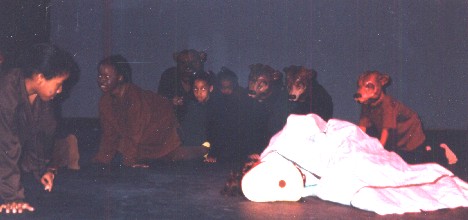![]()
Scott Joplin |
Treemonisha |
|
|
Act I: Lucy, after a lucky escape, relating the events of the kidnapping of Treemonisha.L-R Principals: Ann Gordon, soprano, singing Treemonisha’s mother, Monisha. On her knees with the white apron, Melanie Brandon, soprano, playing the part of Lucy’s mother. On her hands and knees in white, soprano Gayle Vanderhorst, singing Lucy, Treemonisha’s friend. Performance at the Hallam Theatre, Largo Maryland, May 1997. |
|
Opera in three acts, duration 1 hour 45 min., one 10-min. intermission |
|
TREEMONISHA is a delightful work for
audiences of every age, race, and creed. Its message is "Education is the Way to
Freedom"— essentially of Black pride and self improvement. "It may
be the only opera ever composed whose protagonist is a school teacher" [Joseph McLellan, The Washington Post, Nov. 1986] and a teen aged girl at that!
The Characters include:
Joplin wrote his own libretto. Written in 1911 and 1913, the scene, set in 1864, is laid on the abandoned John Smith plantation somewhere in the state of Arkansas, northeast of his birthplace of Texarkana, 3-4 miles from the Red River. The plantation is surrounded by a dense forest. Several families live on the plantation, led by Ned and Monisha, and several live in the woods. May of the people were superstitious, and fell prey to the hard selling tactics of the rich conjurers or drug dealers of their day. Ned and Monisha were childless, and their prayers were answered when they found an abandoned mulatto baby left to die under the tree in the front yard. The adopted her, but did not tell the neighbors nor the girl herself until sometime during the opera. Treemonisha, as she was named, was educated (through extra work of Monisha) and at the age of 18 returned to her home town, and the plantation, to take up teaching. There she ran against the grain of the head "witch doctor," Zodzetrick, and the conjurers, who kidnapped her and her girl friend, Lucy, and planned their demise. But she was rescued and the felons brought to justice. When she took the lead, and suggested that they be scolded, preached at, and released, after some time she was elected as the leader of that community, very strongly supported by the male characters of the cast, as well as the female - an idea of Joplin’s that was way ahead of its time. The form of the opera is of any grand opera of the time, with overture, recitatives, arias, choruses, community dances, a ballet, and, surprisingly, a barbershop quartet. The musical style is an amalgam of European styles of the late 19th century, neo-romantic 20th century, and African-American idioms. Joplin, the King of Ragtime, is also master of choral writing, with 19 of the 27 numbers written for the chorus. --Nevilla E. Ottley |
|
 |
|
| Students of the Ottley Music School acting as bears, investigating the tied and gagged Treemonisha, who had been kidnapped by the conjurers | |
| Colombo | A Secular Cantata In Four Parts for Soli, Chorus and Orchestra edited by Nevilla E. Ottley |
| Antonio Carlos Gomes
(1836 - 1896) |
duration 2 hrs., 1 intermission
|
| COLOMBO is an operatic-like work composed by the African Indian Brazilian opera composer, Antonio Carlos Gomes in 1892 for the Columbus Festival in Philadephia, PA in 1892. This wonderful work is not part of the traditional literature in the US, even though it is still performed in Brazil. The four-act work written in Italian calls for a cast of 4 principals, 3 supporting roles, choruss of sailors, nuns and priests, soldiers, people of the court of Spain, "natives" of the New World, and the populace of Barcelona. The cast includes Columbus, the explorer (baritone), Il Frate, Friar of La Rabida monastery (bass), Fernando, King of Argon (tenor), Isabella, Queen of Castille (soprano), with Mercede, lady-in-waiting (mezzo-soprano), Don Ramiro, a gentleman of the court (tenor), and Don Diego, a nobleman of Spain (baritone). There are also "native" dancers and Spanish dancers for Act IV. by Nevilla E. Ottley | |
| Samuel Coleridge Taylor (1875 - 1912) |
The Atonement |
|
|
| The Nevilla Ottley Singers at Takoma Park
Seventh-day Adventist Church on February 7, 1998 in performance of Samuel Coleridge
Taylor's oratorio, The Atonement. Front, director, Nevilla E Ottley
|
|
[Mark Fax*]
A Christmas Miracle, opera in 1 act, duration 50 min., can be coupled with Amahl
[Gian-Carlo Menotti]
Amahl and the Night Visitors, opera in 1 act, duration 50 min., couple with ...Miracle
[Samuel Coleridge Taylor*]
Hiawatha’s Wedding Feast, secular cantata in 1 act, for chorus, 1 tenor aria. 40 min.